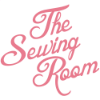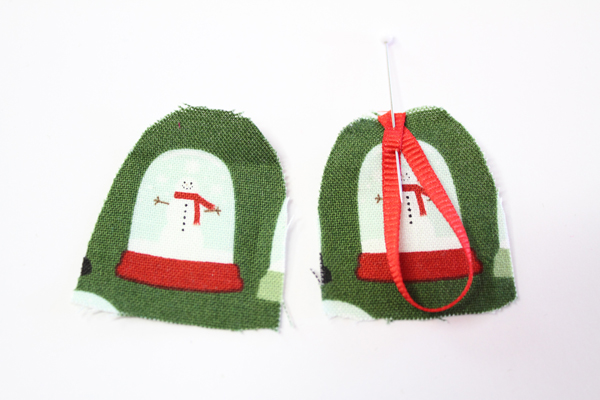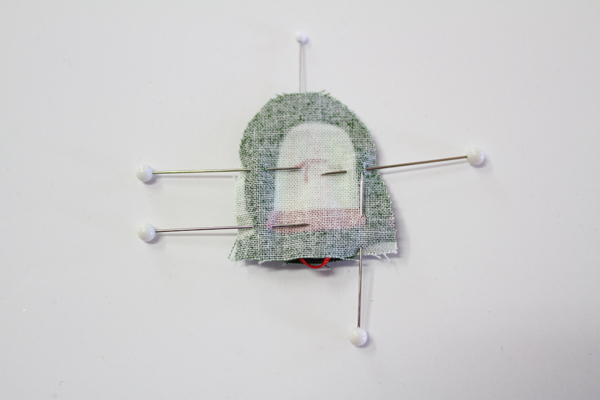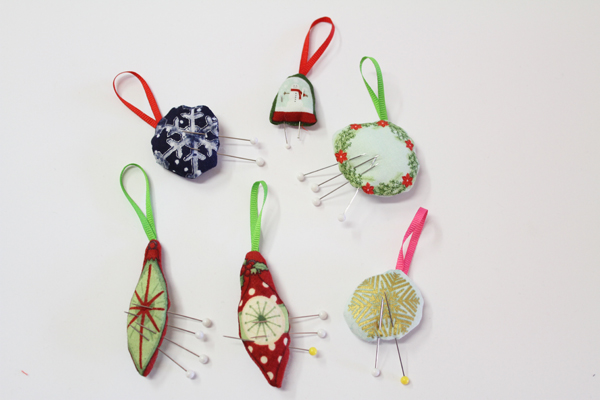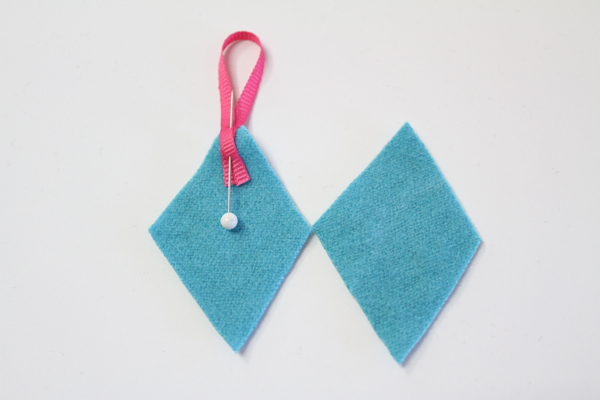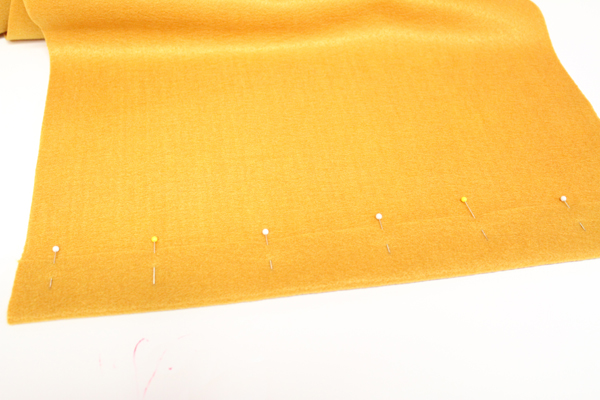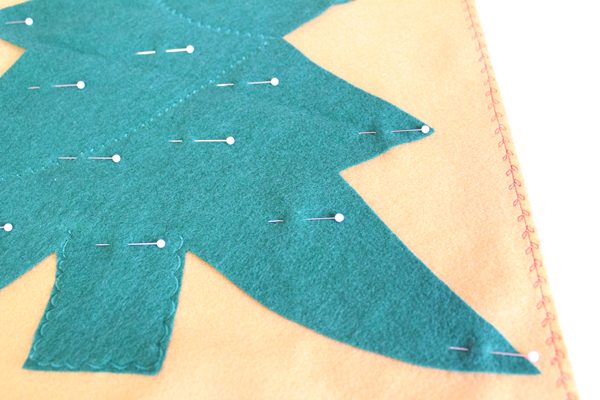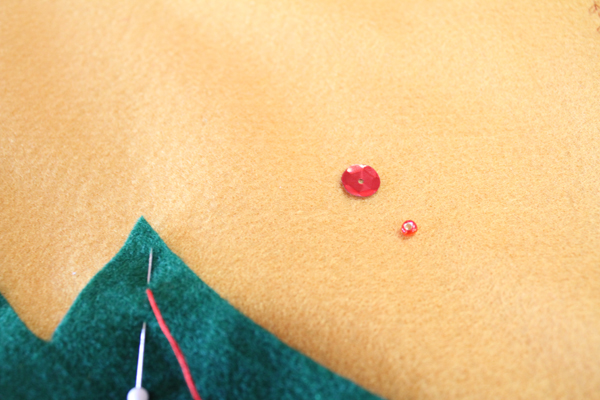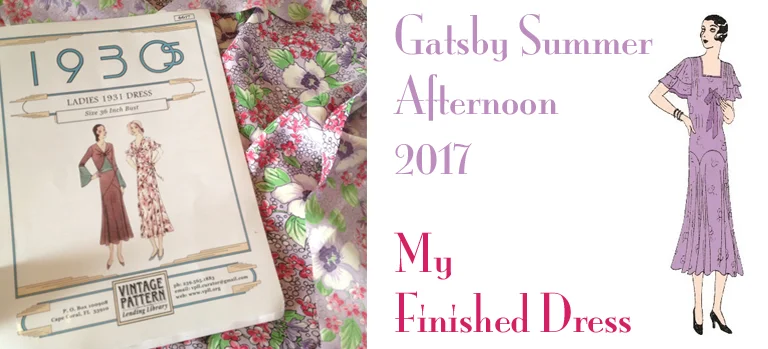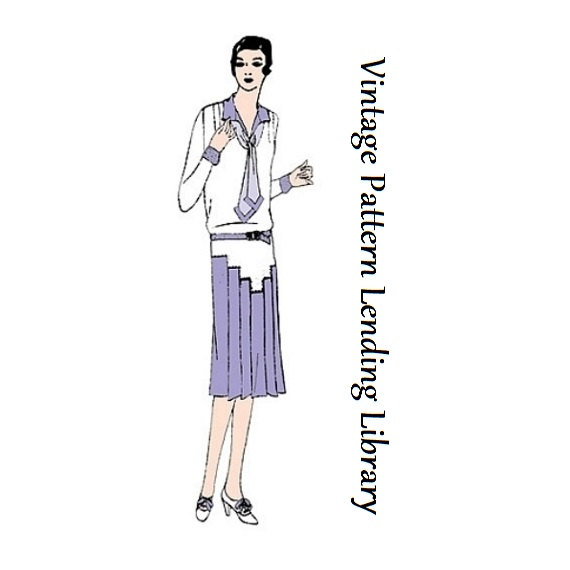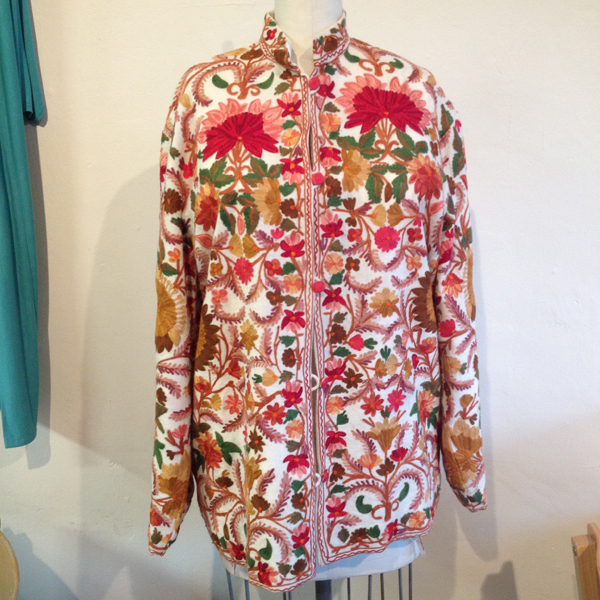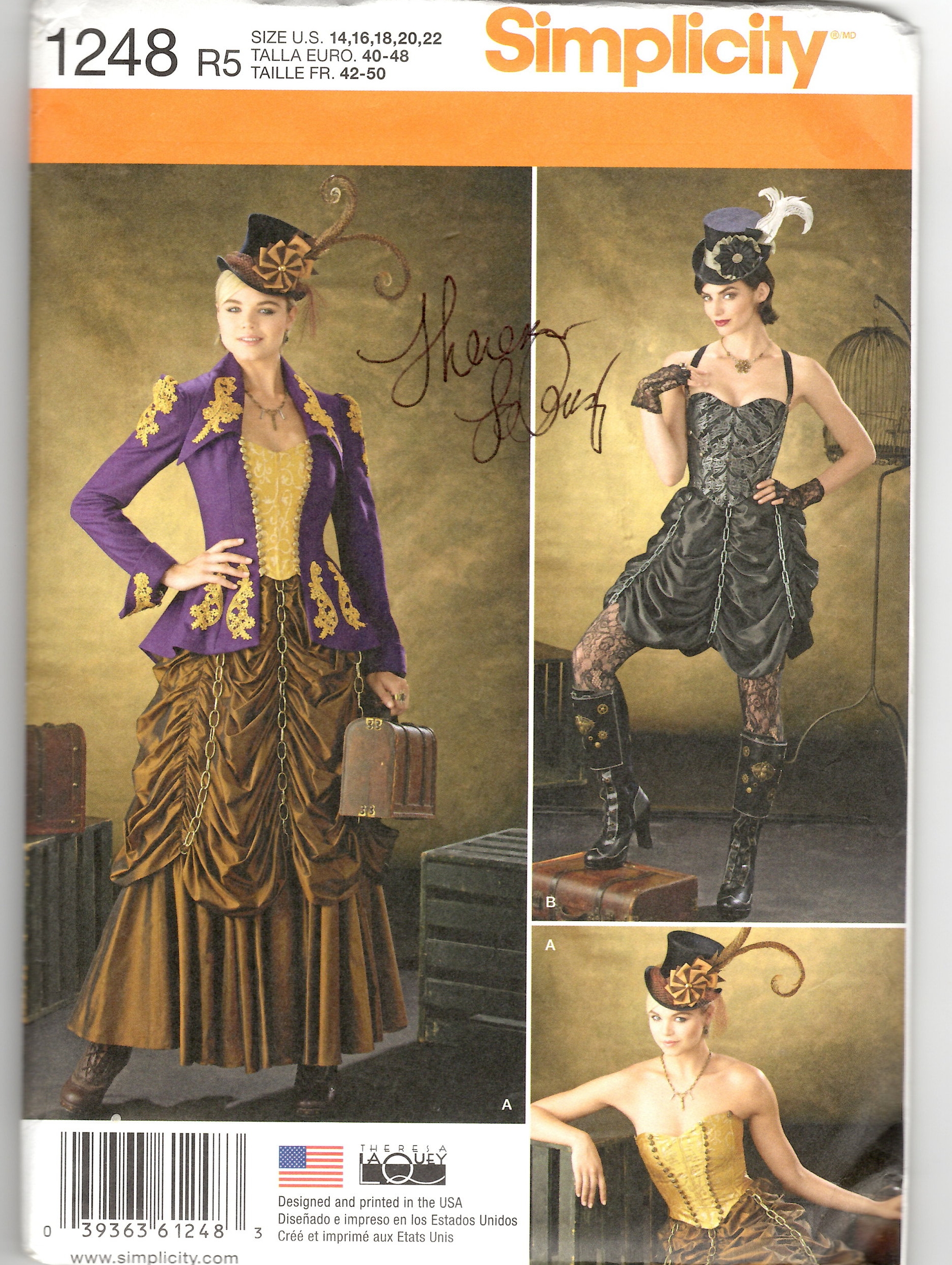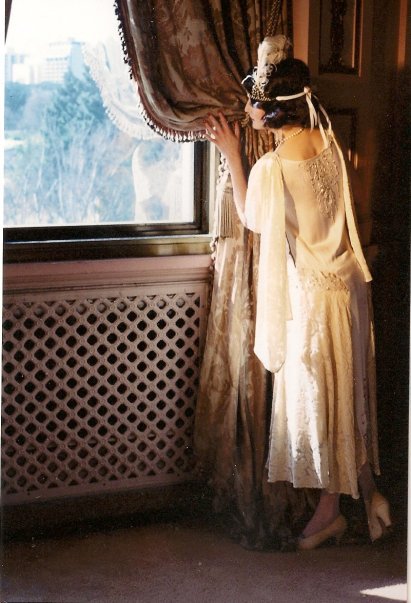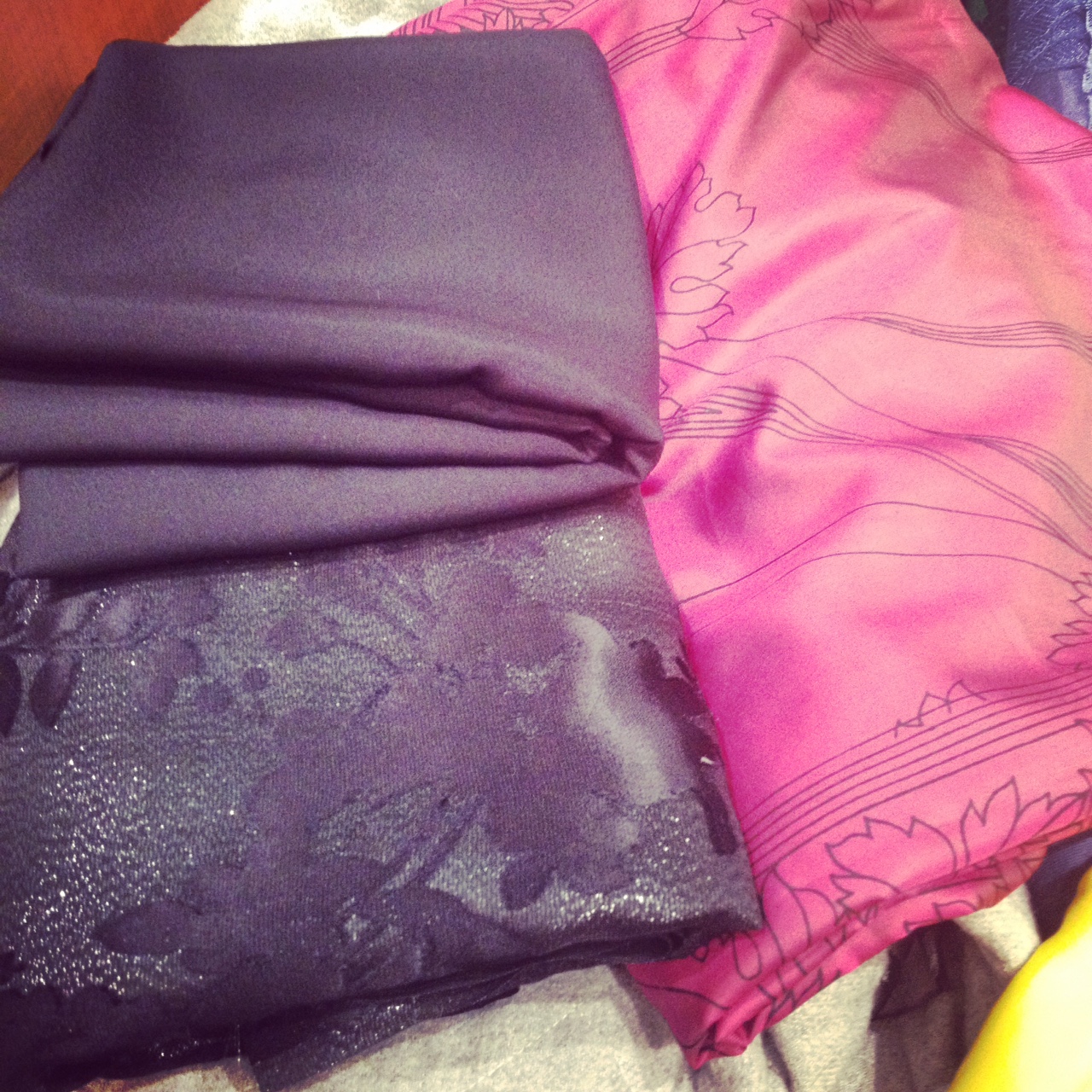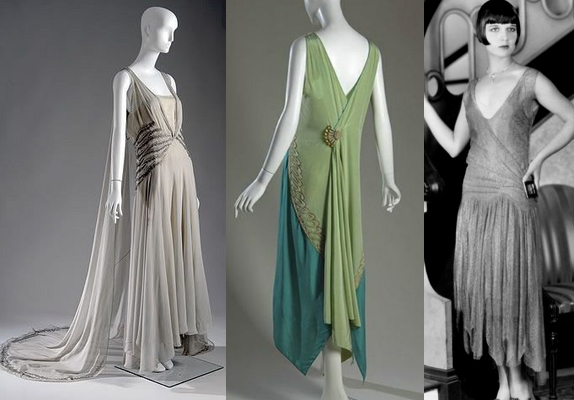This outfit all began after a short trip around the corner to my local crafting consignment shop, where I found the amazing fabric for the blouse featured in this post. The print (Asian Art Deco?) was irresistible and there was just enough of it to scrape out a blouse. Next up was a search for the perfect 1930's blouse pattern. That proved to be a little easier said than done, as I had trouble finding a blouse pattern that suited the fabric. I did settle on a gorgeous 1930's dress pattern with a fabulous neck bow, that could be converted into a blouse and skirt.
Read moreMiss Fisher Wardrobe: The Basic Shell
In my recent post, December Red, I showed a red wool 1930's skirt and coat. This 1930's style skirt is a bit of an ode to skirts worn by the Honorable Miss Phryne Fisher, in Miss Fisher's Murder Mystery series. Her character is quite fashion forward for the 1928-1929 timeline the series is set in and her clothing and style, in general, seem to echo both decades (1920's & 1930's). So, I needed a top to pair with this skirt in my quest for a Miss Fisher Wardrobe.
Read moreSmooth Sailing Sports Togs- A Pattern Review
Pictured here is a 1940's (or late 1930's) outfit that I sewed up using the Wearing History Smooth Sailing Sport Togs Shirt and Trousers pattern. LOVE, LOVE, LOVE!!!! This pattern is great. The blouse needs a little work in the armhole, but otherwise...
Read moreGet Crafty for the Holidays - Make a Vintage Style Advent Calendar
In the 1970's my aunt Sharon made our family an Advent Calendar. It's crafted almost entirely of acrylic felt and quite a testament to the crafting movement of the era. I'm very sentimental about it, even though we were not particularly religious, growing up. I just remember waking up each day, excited to put another ornament on the tree. Thankfully, my mom kept it around for the years after I left home and then gave it to me later on. We carry on this tradition at home today and my 14 year old daughter feels as sentimental about it as I do.
This is the "Vintage" Advent Calendar that we use for Christmas every Year
Here are some of the ornaments that hide in the pockets of the calendar.
A few months ago, one of my dear Bridal clients (from when I did that) dropped by to donate some sewing materials her son acquired from an estate sale. Inside were these tiny little ornaments, exquisitely and painstakingly beaded. I knew they would come into some use, when I saw that they were all Christmas themed. So that is what led me to re-make this wonderful holiday craft. I've put together 6 kits that we are selling ($50 each) with either a mustard or Aqua background. You can buy them from me, or make your own using the directions below. Either way, I hope you enjoy! And Happy Holidays to you and your families!
Directions for Advent Calendar:
Materials list -
- Craft Felt - Wool or acrylic in multiple colors - 1 rectangle measuring 36 1/2" long x 17" wide, 3 rectangles measuring 2 1/2" long x 17" wide (for pockets) in the same background color, 3/4 yard green for the tree and misc. felt squares for the ornaments.
- Ribbon or cord for the ornaments - 2 yards narrow width (1/8" or smaller)
- Cotton holiday print fabric for ornaments - I bought several fat quarters and then cut out the shapes as they were the perfect size. Note: You may have to do some hunting around to find the right fabric, or just make more ornaments out of felt. Our calendar has little pieces of holiday cards with ribbon hangers glued on in addition to the felt ornaments.
- Various additional tiny ornaments that are small enough to put in the pockets - I bought these from a craft store. note: you need 24 ornaments in all, so it's nice to have a few that are already made.
- A small amount of polyester or cotton fiberfill for stuffing the ornaments.
- 1 package of large red sequins - I think ours were 8mm and you will need 24 total.
- 24 small glass beads - these are used in combination with the sequins and the ornaments will hang from these
- (1) 3/8" diameter wooden dowel 18" long - I had an 1/8" whole drilled 1/2" away from each end.
- 36" of narrow (1/16") cording for the hanger.
- Misc. beads and sequins for decorating the ornaments.
- Thread, sewing machine, waxy tracing paper (for transferring numbers), tracing wheel and all your standard sewing tools.
STEP ONE making the fabric ornaments -
- Cut around shapes leaving 1/8"-1/4" seam allowance. You will need two for each ornament.
- Cut a 3" piece of narrow ribbon or cord for the hanger and pin in place as indicated in the photo.
- Place right sides together and pin around outer edge.
- Stitch around outside edge, leaving small space along the bottom, to turn right side out.
- Turn ornament right side out and stuff with a little bit of fiberfill.
- Fold seam allowances to inside and pin in place. Hand stitch closed, using a slip stitch or ladder stitch.
STEP TWO - Making the Felt Ornaments
- Cut two pieces of felt in the shape you want (we have a diamond shape and a rectangle pictured).
- Cut 3" long piece of narrow ribbon or cord and pin to wrong side of felt at top of ornament, as indicated in the photo.
- Place a small amount of fiberfill on wrong side of one piece and place the other side of the ornament with wrong sides together.
- Pin around outside edge then stitch together around entire outside, making sure to catch the hanger in your stitches.
- Decorate your ornaments with top stitching or beads as you desire.
STEP THREE - Prepping the pocket rectangles
- Sew a decorative stitch across the top edge (on long edge) of each pocket rectangle. I use this same stitch for all the decorative stitching on the back ground pieces and the pockets, but feel free to change it if you want to use more of the stitches your machine offers. Note: you do not want to use stitches that will be wider than 1/4" as this will make the pockets too small.
- Trim the rectangles to fit the background width.
STEP FOUR - Transferring the numbers to the pockets.
- In my kit, I've created a template for the numbers. If you are doing this on your own, you will need to create a template. It's easy to do in Microsoft Word or Google docs. You will just need to create a TABLE with columns measuring 2" wide x 2 1/2" tall with 1/8" wide columns in between. Find a font you like and type in numbers 1-24 in each of the larger cells. Pick a font size that works so that the numbers fill up the box.
- Print and cut out, your numbers, then tape them together in 3 rows: 1-8, 9-16 & 17-24. Make sure they fit within the 17" width with 1/4" space on the outer edges.
- Transfer the numbers to the pocket rectangles using tracing paper and a smooth edged tracing wheel.
- Filling in the Numbers - I stitched on the transferred numbers using a machine straight stitch and had to go over them a few times. You can also hand embroider the numbers or use fabric paint. The original calendar was done using fabric paint.
STEP FIVE - Creating the dowel casing
- Fold top edge of calendar rectangle (background) to back side 1 3/4" & pin in place.
- Using a decorative stitch, sew a line of stitching across the top edge using 1/2" seam allowance.
- Using the same decorative stitch, sew another line of stitching across the top edge using 1" or 1 1/4" seam allowance. There should be at least a 3/4" space between the stitch lines.
STEP SIX - Finishing the Pockets
- Place the finished pocket rectangles at the bottom of the background rectangle on the front side. The rectangles should be flush to the sides and bottom edge and 1/2" apart. Pin in place.
- Using a decorative stitch, stitch around the outside edge of background rectangle, starting and ending at the lower dowel casing stitch line,You do NOT want to stitch through your casing. Also, make sure your decorative stitch lands about 1/8" away from outer edge.
- Mark vertical lines, either with chalk or a steam away pen, between the numbers. Then, stitch between the numbers, vertically, along those lines, using your decorative stitch.
STEP SEVEN - Attaching the Tree
- In my kit, the trees have been pre-cut . If you are making this on your own, you will need to create a tree pattern. Ours measures 20" long x 16" at the widest point. There are 5 branch points on each side tapering in fullness from bottom to top.
- Place your tree evenly between the two sides and between the pockets and the bottom edge of dowel casing. Pin Trunk in place.
- Using a decorative stitch, stitch trunk in place, around it's three edges.
- Pin tree in place so it won't move and, using a decorative stitch, stitch swags diagonally across tree.
- Note: the original calendar had the tree glued in place in various spots. I chose not to clue, but to sew, in order to secure the tree in place.
- Mark the spots of your sequins by placing 24 pins through the tree in an organized fashion. Take a look at the finished tree for general placement.
STEP EIGHT - Sewing on the sequins (ornament holders)
- Divide a strand of embroidery floss into sections. Mine has 6 plies and I divided into two strands of 3 plies each.
- Thread a needle with your floss and, from the back side, pock through the tree at one of the pinned positions. Leaving about 1 1/2" of thread on the back side, load a Sequin (curved edges up) and a bead onto the needle. Push the sequin and pin down the thread to the tree.
- Now, put your needle through the sequin again and back through the tree to the back side of the calendar. The sewn bead will secure the sequin in place.
- Using both ends of your floss tie a double knot to finish securing the bead and sequin in place.
- Trim your thread, and repeat for the other 23 sequin/bead ornament holders.
STEP NINE - Dowel & Hanger
- Push dowel through casing at top edge of calendar, leaving 1/2" exposed on each end.
- Using a 36" long piece of 1/16" diameter cording, thread through holes on each end of dowel. (Ends of cording should exit holes toward bottom of calendar. )
- Double or triple knot cording ends on each side, to prevent from exiting holes.
- Note: if you do not have a drill to make 1/8" holes in dowel, just make a slip knot loop at each end of cording and slip on to dowel ends.
You are All Done! Just place ornaments in pockets and hang on the wall on December 1st.
Until next time, Happy Sewing!
xo
Jennifer
1930's Dress Complete - Gatsby Summer Afternoon 2017
The Gatsby Summer Afternoon is an annual event presented by the Art Deco Society of California, every year on the 2nd Sunday in September. This is an event I look forward to each year and get ready for, pretty far in advance. For the 3 years, my mom has been joining me and then last year, my cousins Kathy & Maurice came along for the ride as well. AND this year, I even roped my friend Jone in, who ended up having more friends there than me!
Read moreModern & Vintage - Combine your patterns for a Retro Look
This Dress was a long time coming. I started working on it in November of last year. Originally, I intended to make it from a wool crepe and that the red rayon would be a wearable muslin. Using the Colette Patterns Oolong Dress pattern (purchased for 1/2 price, when they were discontinuing the pattern), I decided to make one modification - add godets to the skirt in the princess seams to give it a little flip and flare....
Read moreSewing My Gatsby Prototype - Using a Vintage Dress as my muslin....
After all your wonderful suggestions, I did end up choosing Ladies 1931 Dress from Vintage Pattern Lending Library for my Gatsby Dress. I just can't seem to get enough of those VPLL patterns! More on THAT later. Here is the story of how I came to use a Vintage 1940's dress for my "muslin" prototype....
Read moreHelp Me Decide which 1930's dress to make for Gatsby 2017
The Art Deco Society of California's Gatsby Summer Afternoon, is right around the corner. Slated for Sunday, September 10th, this annual event will take place on the majestic grounds of the Dunsmuir Hellman Estate in the Oakland Hills. Hundreds of people enter the grounds dressed to the nines in gorgeous picnic attire....
Read moreTaking a Sashiko Class with Carol Ziogas - Summer Hand Stitching
Summer is my busiest time of year so I only work on projects I can pick up and put down easily and those that travel well. That usually translates into hand sewing or knitting. So, when The Recrafting co., my local (crafting) consignment shop, had a posting a few weeks ago for a Sashiko Sewing class, I could not pass it up.
Read moreMaking an Art Deco Inspired Shrug - 1920's Inspiration
My friend Jonathan invited me to his 30th birthday party. He wanted to leave his OWN roaring 20's in style and asked everyone to come dressed up for the occasion. What a great opportunity to play dress up and put on a made-by-me gown from my favorite era!
Read moreA 1920's Blouse Done 3 ways with One Vintage Dress Pattern - Miss Fisher Wardrobe or Bust!
The original pattern
As part of my quest to build a "Miss Fisher" wardrobe, I've sewed up three little blouses inspired by separates her character wears in different episodes. This post will show you 3 blouses I have made, starting with one pattern and explain how you can do it too!
Read moreCreating a Skirt from a 1930's Dress Pattern
Vintage Pattern Lending Library Pattern #T3221
Recently, I've given myself the task of creating a "Miss Fisher" wardrobe....
Read moreHere at Last - The Art Deco Preservation Ball
Well, the day of the ball arrived and I was prepared! This year's theme was Death on The Nile (the Agatha Christie Murder Mystery) with a focus on Egyptian Revival of the Art Deco era.
Read moreFull Bust / Narrow Shoulder Adjustment - Fitting my Embroidered Jacket
This jacket was found at the Vintage Fashion Expo in the Michaan's Auction House out at Alameda point last Fall. I loved it immediately and was pleased to say that it fit fairly well upon first trying it on, all be it, a little loose. This beautifully embroidered piece was only $45, so I nabbed it up and took it home.
Once home, I kept trying it on with different outfits and just found that I felt a bit frumpy in it. Have you ever had this experience? My bust and hips are full, at least in comparison to my shoulders and rib cage. The difference in size is about 3 dress sizes. Yikes. I'm the typical "Pear" - size 4 in the shoulders and rib cage, size 8 in the bust and a 10-12 in my waist andhips. Makes for a difficult fit a lot of the time. Well, this car coat (that's what these short jackets are called) is just a little too "Miss Fisher" to give up, so after close inspection, an alteration seemed in order.
"What to do?" You ask. Well, I say, make it fit in the shoulders. I started by pinning out the shoulder to see how much needed to be reduced - about 2" in the end.
After seam ripping the sleeves off the jacket, I drew a new armhole on the jacket, making the shoulders 2" smaller on each side. This made the armhole quite a bit larger than the sleeve.
In order to reduce the armhole measurement so that the sleeve would fit, I created a dart along the sides of the jacket, as there was no side seam to reduce. This made the bust smaller as well, but that worked out just fine, as the jacket was quite full in the bust already.
The sleeves were sewn back into the garment and the lining pinned in and stitched by hand.
With my jacket altered, and fitted properly, I now love it even more. Time to make an outfit to go with it, don't you think?
Happy Sewing!
Building a Miss Fisher Wardrobe
my Miss Fisher Mood Board that inspires me to dress like this sassy lady!
Have you seen Miss Fisher's Murder Mysteries? It's an Australian TV show based on the Kerry Greenwood Novels. The series highlights the Honorable Miss Fryne Fisher, who is a lady detective in the 1920's, and is played by the brilliant actress, Essie Davis. TheFryne character is the epitome of the strong, sassy, smart woman that I would love to be. AND she has a fantastic wardrobe.....
Read moreDesigning Vintage Gowns
Designer Theresa LaQuey at Gatsby Summer Afternoon wearing a Vintage gown of her creation using vintage fabric.
An Interview with Vintage Clothing and Pattern Designer,Theresa LaQuey
In preparation for draping my Art Deco Preservation Ball Gown, I reached out for a little advice and encouragement from Couture Vintage Clothing Designer, Theresa LaQuey. She has a wealth of knowledge, after spending many years creating beautiful bespoke creations for ladies with an eye for vintage style. Our Conversation is below.
Additionally, we will be doing another giveaway this week. Theresa has generously given us an autographed copy of one of the Simplicity patterns that she designed. I'll do a random drawing of our email subscribers to see who wins!
a 1920's style beaded silk and velvet gown photo by Laurie Gordon
Gorgeous vintage style by Theresa LaQuey on the Red Carpet!
Jennifer: Theresa, I'll likely drape a late 20's look in silk charmeuse and chiffon and will probably take a trip to Britex Fabrics for some pretty beaded appliques. A friend gave me a purple and yellow ombre length of silk, that I intend to use for the main part of dress. I think the purple yellow combo will be my ode to Egypt but maybe I'll do a fun head dress as well. I'm still in the planning stages. Do you have any advice as to how I should begin?
Firstly, I so admire your thoughts on draping your gown. If I may make a recommendation, try to find the pattern making and draping book that was printed by the Women's Institute of Domestic Arts and Sciences, Scranton PA, published in 1928?? I think. When I was learning my trade, a dear fellow student gave me a xeroxed copy of that book. It made all sorts of dress making from the 1920s very plain and simple. Just geometry and physics.
I do not give a good review on getting purchased appliqués. I have had very bad experiences with them. They are too stiff and don't look correct. It sounds cruel, but get a dead dress and cut it up. You will do better with it. (note from Jennifer - I think this is a great idea!)
I would like to teach you to bead. I know the Tambour method. It takes about one hundred hours to learn it, and another couple of thousand hours to perfect it. But oh boy it is worth it.
However, purchased appliqués can work. Just make sure they are soft, not stiff. Also, give a call to the Fashion Company in SF. They have carried appliqués and are very great. Be prepared to meet the minimum of $70.
Jennifer: How & When & Where did you first begin studying bespoke sewing and couture design?
Well, my mother was the costume designer at Diablo Valley College (DVC) and my whole family has been stitchers for at least 100 years. My mother was paid so poorly and because of that, I started hanging out in the costume department with my mom at age 5.
(Later in life) I was in the punk scene and got married to the lead singer of the Dead Kennedys. He was a collector of vintage records. That’s when, I started collecting vintage patterns. After we broke up, I started the apparel design program at DVC. It was a fantastic program. If you want to get into design, don’t spend $30,000/year. Go to a community college. It’s an amazing experience.
Then, in 1987, I ended up partnering with Mark Jones, making couture gowns and learning how to bead..
Our very first commission was a wedding gown was a replica from a movie Topper with Constance Bennett and Cary Grant. I had to have foot surgery and I spent my time, in bed with my feet up, beading that gown.
Jennifer: At the Art Deco Preservation Ball 2 Years ago, I was completely impressed with all the glamorous ladies walking around that evening, at the Oakland Scottish Rite. Each woman looked spot-on, and I thought for sure they were all wearing mint condition vintage. Then later that night you were honored with a special display of all the ladies wearing your gowns (I think there must have been over 30 ladies standing up near the stage) and nearly all of the gowns on display were the exquisite designs I had been admiring earlier . It was wonderful seeing the variety of designs you produced from the Art Deco Era and the 1930’s styling in particular. Is this your favorite era? Or just the one most on display?
It’s my favorite era ever. I consider myself more of a mathematician than a designer. It sounds crazy but you are dealing with the geometry of stretch, when it comes to Bias. When you get into the 30’s they are really applying that “wonderful” of the 1920’s to the feminine form. One tip - Avoid Side seams. The 1930’s is my favorite (era) because it’s so unexpected. If you go in there like an explorer, you’ll learn a lot about making clothes.
This is a section of bead work made by Theresa
an Adrian Inspired Gown by Theresa- photo by Laurie Gordon
Jennifer: Are your couture gowns original designs, inspired by the era, do you use vintage patterns or a combination?
A combination of both. We have a joke around the house that I’ve copied so many Adriens that we call them LaQuey-driens. I’ve done plenty of original designs as well. Mainly I do bespoke (gowns) only for friends, these days.
Jennifer: For this year’s preservation ball, I will be draping a gown in the late 1920’s style. When I made my gown two years ago, I made a corset to go under. The pattern was reproduced from a 1920’s pattern and had the perfect silhouette for the straight lines of my gown. I’m planning to do the same this year but for a dress that will have a little more shape appropriate to the later 1920’s. Did you ever make foundation garments for your gowns? Did you build foundations in the garment?
I have built foundation garments into gowns but they are more 1950’s gowns. The thing about 30’s gowns especially, is that they should look like they were blown on to the body and just land there.
Jennifer: Do you have a favorite material to work with for vintage gowns?
Yes, I do - My super-duper favorite - a 1930’s red & white ensemble. A Japanese fabric called Chirimin crepe. It’s a rayon pebble crepe and only 36” wide. You can find it at www.fabrictales.com
These ladies are incredible. The weight of the fabric is incredible.
Then I have a supplier out of the east coast and Los Angeles - Eastern Silk Co. (trade only) they carry 4ply crepe and crepe back satin in 144 colors.
C&J Textiles in NY - the fabric they carry for called Silk Vanity - The colors are gorgeous. I’m working on another gown this month in this fabric.
Jennifer: Along the same lines, do you have a favorite gown that you’ve made? Who did you make it for? Would you describe it for us or do you have a photo?
I do - Do you know of Mr. Pear? I worked with Mr. Pearl last year and we did a dress together for a burlesque artist.
From my own projects I would have to say the Chanel Fireworks dress. It was so hard. All beaded. Black Chiffon with poly-chromatic sequins. Every time you have to knot off each sequin individually. It’s a beautiful evening gown. The woman who wore it is incredibly elegant.
The Fireworks Dress
Jennifer: You always look so fantastic when I see you at Art Deco events. Do you dress in Vintage everyday?
I do not wear modern clothing. Most of the time I spend in trousers and a turtleneck. I used to wear beautiful clothing but it always gets ruined. I do not wear makeup either.
I have a pattern for some vintage trousers and have made up about 6 pairs of them. The woman on the cover of the pattern, is standing there, roasting a weenie.
I wear turtle necks in the winter and the rest of the time I wear “The Blouse” which is made from a 1930’s pattern.
Jennifer: After seeing your beautiful couture work for years, I found out that you make sewing patterns as well. What kind of patterns do you specialize in? And where can we buy them?
Simplicity patterns. My sister is Andrea Schewe and she got me the job. She was designing for Simplicity. It’s so crazy. I have 3 sisters. Andrea is 10 years older than me and our older sister convinced her to go to NY.
I went to celebrate my sister's wedding anniversary and Andrea told me to bring my portfolio. I sat down, with Simplicity Patterns, and they looked through my portfolio and they asked me “ What could you do for us?” I did a swing skirt. I made it up. It ended up selling 25,000 copies.
Then, I got assigned Steampunk. I had just done a Steampunk wedding and was so grateful. I became top designer at Simplicity afterward. That means your pattern is outselling everything else. My sister has been top designer as well.
Jennifer: Thank you so much for giving this interview and for generous giveaway of an autographed pattern! Finding out more about you and hearing all your sage advice has been priceless!
YOU can find out more about Theresa and see more photos of her exquisite creations by visiting her Facebook Page.
The Making of a Hat - How I achieved my 1920's Miss Fisher Look
Having acquired all the materials - wool hat (a la Old Navy), millinery wire, ribbon aplenty and a beautiful feather rose, I was ready to make my hat for the Girl's Inc. Hat's off to Women Who Dare event. Yay! I love decorating hats and making them very special.....
Read moreDesigning my (Art Deco Preservation Ball) Gown
For me, it usually starts with Fabric. This time, I was lucky enough to be gifted two beautiful pieces of silk from my friend, assistant and fellow fabric-lover, Maria Chenut....
Read moreHat's Off to Sewing Blogger Chuleenan Svetvilas of Csews.com
Chuleenan Svetvilas - photo by Portraits to the People
One of my Goals in my Vision for 2017 is making a Roaring 20's hat to wear to the "Hat's off" event which benefits Girl's Inc. With this in mind, I set out to talk to an expert, and the first person I thought of was the organizer of the Bay Area Sewist meet-up Group that I attend. In addition to facilitating our meet-up group she also runs the blog CSews and is a guest blogger for Britex Fabrics. She always wears such fabulous hats and I know that she makes some of them. Below is our conversation. I hope you find it as gripping as I did!
Read moreWorking on my 1930's Foundation - Getting ready for the Art Deco Preservation Ball
Dresses from the late 1920's that show the silhouette of the times (from my Pinterest board).
I've embarked on creating a foundation for my dress that I'll wear to the Art Deco Preservation Ball at the End of April. I really want to create the right silhouette for my dress which will inspired by the late 1920's / Early 1930's. My figure, at age 47 doesn't quite fit naturally into that era, so I definitely want an undergarment that helps me re-create the look....
Read more